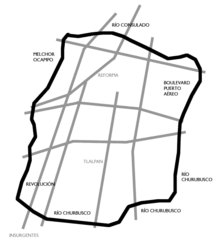Circuito Interior



The Circuito Interior Bicentenario ("Bicentennial Inner Loop") or more commonly, Circuito Interior or even more simply Circuito, is a 42-km-long urban freeway (in parts) and at-grade boulevard (in others), forming a loop around the central neighborhoods of Mexico City. It was built starting in 1961.[1] The Circuito Interior received the appellation Bicentenario (Bicentennial) after a renovation that took place in 2010, Mexico's bicentennial year.
History
In 1951, 8 km of the Río Consulado river's course between the Monumento a La Raza and Mexico City Airport was put underground and the route was opened as a highway. Regent Ernesto P. Uruchurtu decided upon the routing underground of more stretches of the rivers Río Consulado, Río Churubusco and Río de la Piedad. An 18-km route was completed in 1961. In 1974 the Circuito was extended to the south and west, which according to sources at the time resolved 50% of the intersections with severe traffic congestion, with the support of the additional controlled-access roads Río San Joaquin and Parque Vía, together with the construction of the feeder roads Tacuba, Los Hongos and Chapultepec.[2] Its eastern and western parts were finished in 1976.
Section names
Along its course, each section of the Circuito has a specific name:
- Boulevard Puerto Aéreo (from Norte 184 to Avenida Fray Servando Teresa de Mier)
- Avenida Río Consulado (from Norte 184 to Insurgentes Norte)
- Paseo de las Jacarandas (from Insurgentes Norte to Ricardo Flores Magón)
- Avenida Instituto Técnico Industrial (from Ricardo Flores Magón to Ribera de San Cosme)
- Calzada Melchor Ocampo (from Ribera de San Cosme to Paseo de la Reforma)
- Maestro José Vasconcelos (from Paseo de la Reforma to Eje 4 Sur Benjamín Franklin)
- Avenida Revolución (southbound) and Avenida Patriotismo (northbound) (from Eje 4 Sur Benjamín Franklin to Molinos)
- Avenida Río Mixcoac (from Molinos to Insurgentes Sur)
- Avenida Río Churubusco (from Insurgentes Sur to Viaducto Río de la Piedad)
- Avenida Jesús Galindo y Villa (from Viaducto Río de la Piedad to the junction with Avenida Fray Servando Teresa de Mier)
References
- ↑ Arturo Páramo (June 3, 2011). "Circuito Interior una arteria que cumple hoy 50 años" [Circuito Interior, an artery that is 50 years old today]. Excélsior (in Spanish). Retrieved September 11, 2011.
- ↑ Espinosa López, Enrique. Ciudad de México, compendio de su desarrollo urbano, 1521-2000 [Mexico City, Compendium of its Urban Development, 1521-2000]. México, D.F.: Direccion General de Publicaciones IPN. ISBN 970-36-0065-4.